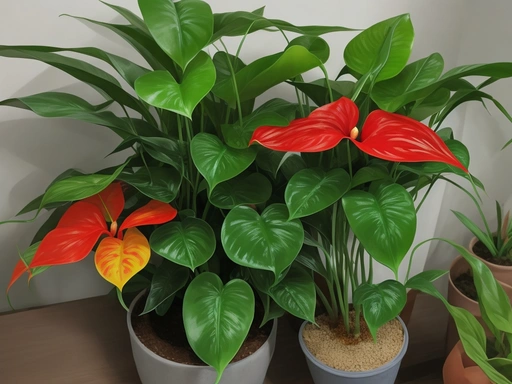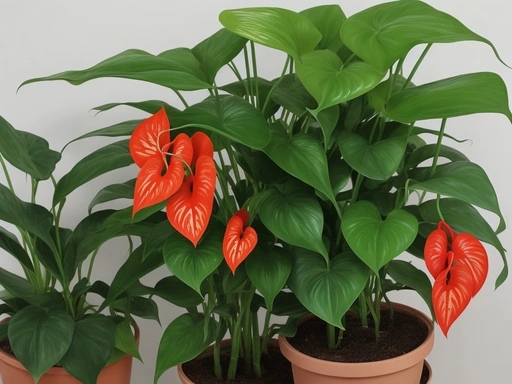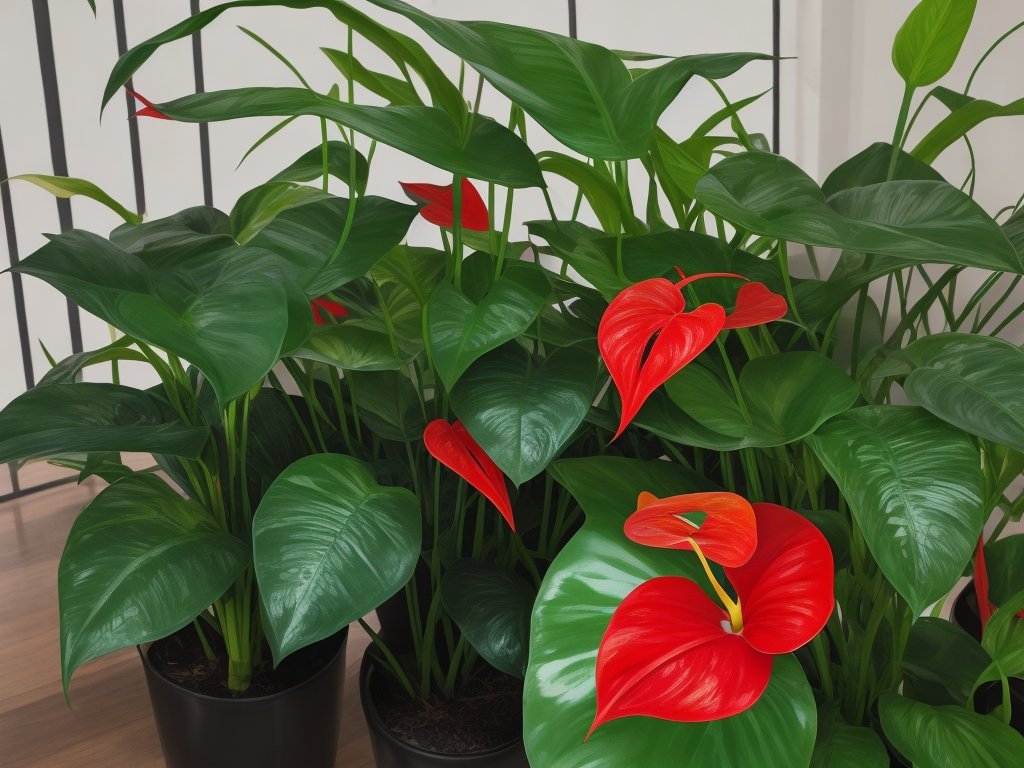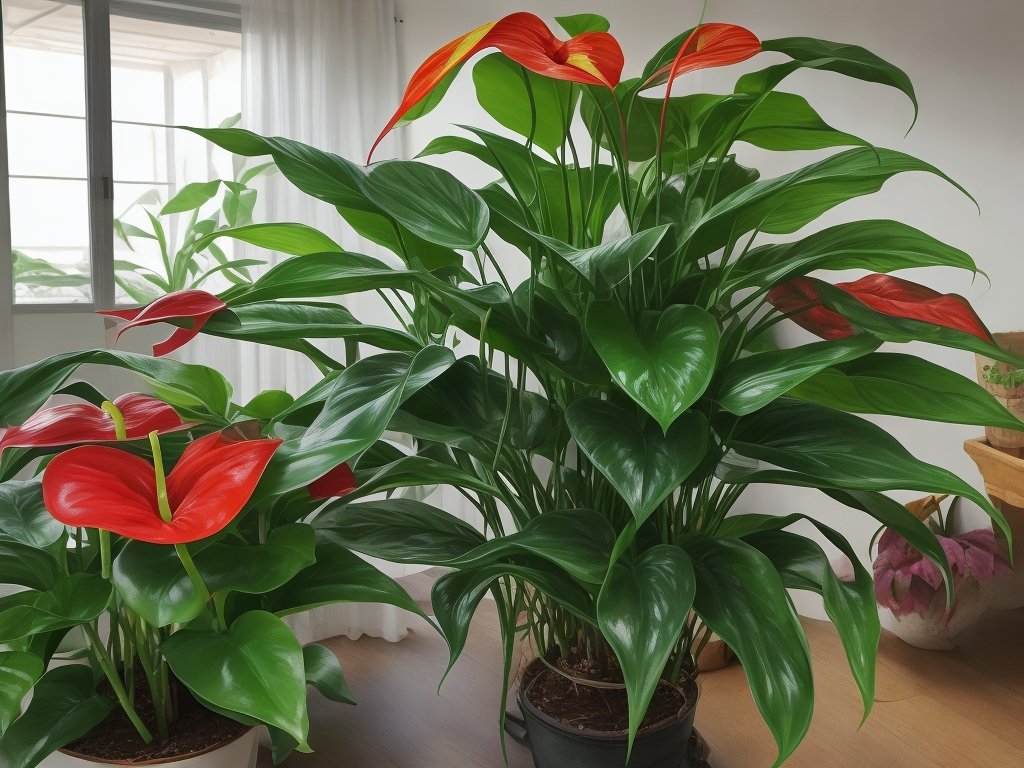Anthurium Propagation Methods: Easy and Effective!
Key Takeaways:
- Anthurium plants can be propagated through division, stem cuttings, and tissue culture.
- Division involves separating the plant into smaller sections and replanting them individually.
- Stem cuttings can be used to grow new Anthurium plants by taking a cutting from a mature plant and rooting it in water or a suitable growing medium.
- Tissue culture is a more advanced method of propagation where plant cells are grown in a laboratory to produce identical clones of the parent plant.
Are you interested in expanding your collection of beautiful Anthurium plants?
Well, you’re in luck! In this blog article, we’ll be diving into the fascinating world of Anthurium propagation methods.
Whether you’re a seasoned plant enthusiast or just starting out, learning how to propagate Anthuriums can be an incredibly rewarding experience.
From division and stem cuttings to seed propagation and tissue culture, there are several methods to choose from.
Join me as we explore each method step-by-step, discuss the factors to consider when selecting a propagation method, and answer some frequently asked questions about Anthurium propagation.
Let’s get started!
| Propagation Method | Advantages | Disadvantages |
|---|---|---|
| Seed Propagation | 1. Can produce a wide variety of new cultivars 2. Less time and effort required compared to other methods | 1. Germination process can be tricky 2. Longer time to achieve mature plants |
| Division | 1. Plants that are already mature can be divided and propagated easily 2. Results in genetically identical new plants | 1. Limitation to the number of new plants that can be obtained 2. Potential damage to the mother plant during the division process |
| Cuttings | 1. Faster propagation method compared to others 2. Can produce multiple new plants from a single parent plant | 1. Requires special care and attention to rooting process 2. Potentially lower success rate compared to other methods |
| Air Layering | 1. Allows propagation of plants with difficult-to-root stems 2. Results in mature plants faster compared to other methods | 1. Requires more time and effort compared to other methods 2. May not be suitable for all species of Anthurium |
What is Anthurium propagation?
Anthurium propagation is the process of reproducing new plants from existing ones, allowing you to expand your collection or create duplicates of your favorite Anthurium varieties.
Understanding the basics of Anthurium propagation
Understanding the basics of Anthurium propagation is important if you want to successfully propagate these beautiful plants.
There are several methods you can choose from, such as division, stem cutting, seed propagation, tissue culture, and air layering.
Each method has its own requirements and success rate, so it’s essential to choose the right method based on factors like your level of experience, availability of plant materials, and the time and patience required.
By understanding these basics, you’ll have a better chance of successfully propagating Anthurium plants.
Different methods of Anthurium propagation
Anthurium propagation can be done through division, stem cutting, seed propagation, tissue culture, and air layering methods.
Division method
Division method involves separating an Anthurium plant into multiple sections, each with its own set of roots and leaves. Using a sharp, sterilized knife, carefully divide the plant at the root system.
Each section should have its own healthy roots and leaves.
Plant the divided sections in separate pots with well-draining soil and provide proper care for their growth.

Stem cutting method
Stem cutting method involves taking a section of the Anthurium plant’s stem and allowing it to develop roots. Here’s how to do it:
- Select a healthy stem with at least two nodes.
- Cut the stem just below a node and remove any leaves.
- Dip the cut end in a rooting hormone to encourage root growth.
- Plant the cutting in a well-draining soil mix or a container of water.
- Place the cutting in a warm and humid location, protected from direct sunlight.
- Keep the soil moist or the water level constant until roots develop.
- Once roots have formed, transplant the cutting into a pot with potting mix, and care for it as you would a mature Anthurium plant.

Seed propagation method
To propagate Anthurium through seeds, start by collecting mature seeds from a mature Anthurium plant. Sow the seeds in a well-draining potting mix, lightly covering them with soil.
Maintain a warm and humid environment for germination.
It may take several weeks to see seedlings emerge. Be patient and provide proper care to ensure their healthy growth.
Tissue culture method
Tissue culture is a method used to propagate Anthurium plants by growing them from small pieces of plant tissue. It involves placing the tissue in a sterile medium, such as agar, and providing the necessary nutrients and hormones for growth.
This method allows for the rapid multiplication of plants and the production of disease-free specimens.
Air layering method
Air layering is a propagation method where you encourage a branch of the Anthurium plant to form roots while still attached to the parent plant. Here’s how it works:
- Choose a healthy branch and make a small cut on it.
- Apply a rooting hormone to the wounded area.
- Wrap the wounded area with damp sphagnum moss and cover it with plastic wrap.
- Secure the moss and plastic wrap with twine or rubber bands.
- Make sure to keep the moss moist and wait for roots to develop.
- Once roots have formed, cut the branch below the rooted area and pot it up.
Choosing the right Anthurium propagation method for you
When choosing an Anthurium propagation method, consider factors such as your experience level, the availability of plant materials, and the time and patience required for each method.
Factors to consider when selecting a propagation method
When selecting a propagation method for Anthuriums, there are a few factors to consider.
Assess your level of expertise, consider the availability of plant materials, and think about the time and patience required for each method.
These factors will help you choose the right propagation method that suits your needs and abilities.

Assessing your level of experience and expertise
Assessing your level of experience and expertise is crucial when choosing an Anthurium propagation method. Consider factors like your gardening skills, previous success with plant propagation, and comfort level with specific techniques.
Evaluate the time and patience you can dedicate to the process and the availability of plant materials.
This will help you select the most suitable method for your needs.
Availability of plant materials
Availability of plant materials is an important factor to consider when choosing an Anthurium propagation method.
You can easily find plant materials such as mature plants or plant parts like stems or divisions in garden centers, nurseries, or through online sellers.
Make sure to choose healthy and disease-free plant materials for successful propagation.
Time and patience required for each method
The time and patience required for each method of Anthurium propagation can vary. Here is a general idea:
- Division method: It requires some patience as you wait for the plant to recover and new growth to emerge. This process may take a few weeks to a couple of months.
- Stem cutting method: Patience is key here as well. It takes time for the cutting to root and establish a new plant. It can take around 4-8 weeks for rooting to occur.
- Seed propagation method: This method requires the most patience as growing Anthuriums from seeds can be a slow process. It can take several months or even up to a year to see significant growth and development.
- Tissue culture method: This method involves laboratory procedures and can take several months for the tissue culture to develop into a viable plantlet.
- Air layering method: This method requires patience as you wait for the roots to develop and the new plant to establish. It can take a few weeks to a couple of months for successful propagation.
Remember, these are just general timeframes and can vary depending on various factors such as environmental conditions and the specific species or cultivar of Anthurium. Patience and attention to detail are key when propagating Anthuriums.
Step-by-step guide for Anthurium propagation methods
Propagation methods for Anthurium plants can be done through division, stem cuttings, seeds, tissue culture, or air layering.
Here’s a step-by-step guide to each method.
Division method: How to divide an Anthurium plant
To divide an Anthurium plant, start by removing it from its pot and carefully separating the root ball into sections.
Each section should have at least a few stems and a healthy root system.
Trim away any damaged or dead roots, then repot each division into its own container using well-draining soil.
Water thoroughly and place in a location with bright, indirect light.
Stem cutting method: Propagating Anthurium from stem cuttings
To propagate Anthurium from stem cuttings, start by selecting a healthy and mature plant. Cut a 6-8 inch section of the stem just below a leaf node.
Remove the lower leaves, leaving only a few at the top.
Dip the cut end in a rooting hormone and plant it in a well-draining potting mix. Keep the soil moist and provide indirect light.
In a few weeks, roots will start to develop, and you can transfer the cutting into its own pot.
Seed propagation method: Growing Anthurium from seeds
Seed propagation is a simple and cost-effective method for growing Anthurium plants. To start, collect ripe and healthy seeds from mature flowers.
Sow the seeds in a well-draining potting mix and cover them lightly.
Keep the soil consistently moist and provide warm, humid conditions. Germination may take several weeks to a few months.
Once the seedlings have grown a few leaves, transplant them to individual pots and continue to care for them as mature plants.

Tissue culture method: Cultivating Anthurium through tissue culture
To cultivate Anthurium through tissue culture, you’ll need to start by selecting a healthy plant with desirable characteristics. Next, gather sterile equipment and prepare a nutrient-rich agar medium.
Take small tissue samples from the plant and place them on the medium.
The samples will develop into plantlets. Transfer the plantlets to a suitable growing environment and care for them until they mature into full-grown Anthurium plants.
This method allows for rapid propagation and the production of disease-free plants.
It’s a great option for those who have experience and access to the necessary equipment and resources.
Air layering method: Propagating Anthurium using air layering
Air layering is a method of propagating Anthurium by creating a new plant from a portion of an existing one. Here’s how you do it:
- Select a healthy, mature stem on the parent plant.
- Make a small incision on the stem and remove the outer layer of bark to expose the inner tissue.
- Apply rooting hormone to the exposed area to stimulate root growth.
- Surround the incised portion with moist sphagnum moss or a similar rooting medium.
- Wrap the moss tightly with plastic wrap or aluminum foil to retain moisture.
- Wait for roots to develop, which usually takes a few weeks to several months.
- Once roots have formed, carefully cut below the established root system and transfer the new plant into a separate pot.
Air layering can be a reliable method for propagating Anthurium and allows you to create new plants with the same characteristics as the parent plant. It’s a great option if you want to expand your collection or share plants with friends!
Frequently Asked Questions about Anthurium propagation
How long does it take for an Anthurium cutting to root?
Anthurium cuttings typically take around 4-6 weeks to develop roots.
During this time, it’s important to keep the cutting in a warm and humid environment, provide proper watering, and ensure that it receives indirect sunlight.
Patience and care are key during the rooting process.
Can I propagate Anthuriums from their flowers?
No, you cannot propagate Anthuriums from their flowers alone.
Anthurium propagation methods typically involve dividing the plant, taking stem cuttings, growing from seeds, tissue culture, or air layering.
Flowers alone are not sufficient for successful propagation.
Is it possible to propagate Anthuriums in water?
Yes, it is possible to propagate Anthuriums in water.
This method involves placing the cuttings or divisions of the plant in water until they develop roots.
Keep the water clean and change it regularly to prevent rot.
Once roots have formed, you can transfer the plants to soil for further growth.
When is the best time to propagate Anthuriums?
The best time to propagate Anthuriums is during the spring or summer months when the plant is actively growing.
This is when the Anthuriums have the highest chance of successful root development and new growth.
It’s important to choose a time when the weather is warm and the plant has enough access to sunlight and water.
Final Verdict
Anthurium propagation is a fascinating and rewarding process that allows you to create new plants from existing ones.
We have discussed various methods including division, stem cuttings, seed propagation, tissue culture, and air layering.
Each method has its own advantages and considerations to take into account.
When choosing a propagation method, factors such as your expertise, availability of plant materials, and the time required should be considered.
By following the step-by-step guides provided, you can successfully propagate Anthuriums and enjoy the beauty of these plants in your own garden or home.
Remember, patience and care are key to successful propagation.
Happy gardening!





